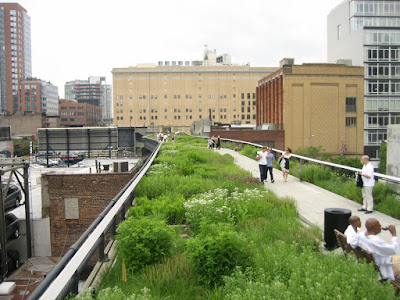You can only see the Tenement Museum by guided tour, and the tour I did was called "Getting By." We visited two apartments, one furnished as it was when a German-Jewish family lived there during the Panic of 1873 (which was described to be a lot like last October...) and the apartment of an Italian-Catholic family during the Depression of the 1930s. Both of these families lived in cramped quarters, but the Italian family had it a lot better than the German family had 60 years before. In 1873, the building on 97 Orchard Street had just 4 outhouses in the backyard, which were used by the residents of the 20 apartments. That's probably an average of 5 person per apartment...you do the math. Gross. No running water, and little air ventilation. This picture from the museum's website shows what their kitchen likely looked like. They would have to haul buckets of water up from the backyard (the water supply, by the way, was right next to the outhouses - not quite sanitary). The stove, which was cast iron, would heat up the whole apartment, which is great in the winter, but not so great in the summer. See any sanitary or efficient means of storing food? Nope. Not so much.

Around the same time that the 100 or so residents of 97 Orchard Street were using the same 4 outhouses on the Lower East Side, on 70th Street and 5th Avenue, wealthy industrialist and art collector Henry Clay Frick was living in the lap of luxury. According to Wikipedia, he was once known as "America's most hated man," and this past April, CNBC named him one of the "Worst American CEOs of All Time." Frick's mansion spans the entire block, and in the 16 galleries, houses works from Frick's personal collection, including works by Rembrandt, Vermeer, Duccio, El Greco, Titian, Turner, Monet, and Whistler...to name just a few. Frick got to wake up every morning and stroll into his outdoor courtyard (which is now covered), right in the middle of his mansion.

Visiting these two museums, in such quick succession, really made me think about the vast disparities in wealth that can be found on one small island. While poor immigrants were starving downtown, rich socialites were gorging themselves uptown. The Tenement Museum tour guide told us that Wall Street was wired for electricity in 1888, but the building on 97 Orchard Street didn't get electricity until 1924. Have things changed since then? Some have, some haven't...but hopefully we're moving in the right direction.
As a side note, at the Tenement Museum visitor's center, they show two short videos about immigrants and the museum. During the credits of one of them, in the special thanks section, "Bernard L. Madoff Investment Securities" appeared on the screen, which I thought was quite ironic and funny. Several other people sitting in the audience snickered.







